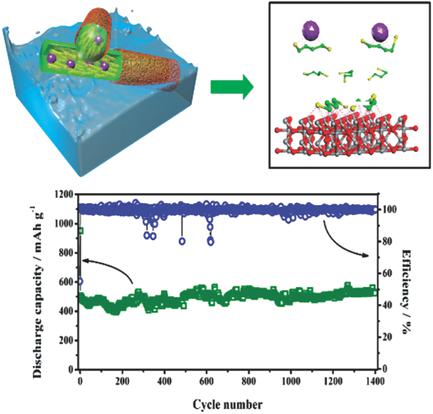当前位置:
X-MOL 学术
›
Adv. Funct. Mater.
›
论文详情
Our official English website, www.x-mol.net, welcomes your
feedback! (Note: you will need to create a separate account there.)
New Strategy for Polysulfide Protection Based on Atomic Layer Deposition of TiO2 onto Ferroelectric‐Encapsulated Cathode: Toward Ultrastable Free‐Standing Room Temperature Sodium–Sulfur Batteries
Advanced Functional Materials ( IF 18.5 ) Pub Date : 2018-01-15 , DOI: 10.1002/adfm.201705537 Dingtao Ma 1, 2, 3 , Yongliang Li 1 , Jingbo Yang 1 , Hongwei Mi 1 , Shan Luo 1 , Libo Deng 1 , Chaoyi Yan 1 , Muhammad Rauf 1 , Peixin Zhang 1 , Xueliang Sun 4 , Xiangzhong Ren 1 , Jianqing Li 2 , Han Zhang 2, 3
Advanced Functional Materials ( IF 18.5 ) Pub Date : 2018-01-15 , DOI: 10.1002/adfm.201705537 Dingtao Ma 1, 2, 3 , Yongliang Li 1 , Jingbo Yang 1 , Hongwei Mi 1 , Shan Luo 1 , Libo Deng 1 , Chaoyi Yan 1 , Muhammad Rauf 1 , Peixin Zhang 1 , Xueliang Sun 4 , Xiangzhong Ren 1 , Jianqing Li 2 , Han Zhang 2, 3
Affiliation

|
The room temperature (RT) sodium–sulfur batteries (Na–S) hold great promise for practical applications including energy storage and conversion due to high energy density, long lifespan, and low cost, as well based on the abundant reserves of both sodium metal and sulfur. Herein, freestanding (C/S/BaTiO3)@TiO2 (CSB@TiO2) electrode with only ≈3 wt% of BaTiO3 additive and ≈4 nm thickness of amorphous TiO2 atomic layer deposition protective layer is rational designed, and first used for RT Na–S batteries. Results show that such cathode material exhibits high rate capability and excellent durability compared with pure C/S and C/S/BaTiO3 electrodes. Notably, this CSB@TiO2 electrode performs a discharge capacity of 524.8 and 382 mA h g−1 after 1400 cycles at 1 A g−1 and 3000 cycles at 2 A g−1, respectively. Such superior electrochemical performance is mainly attributed from the “BaTiO3‐C‐TiO2” synergetic structure within the matrix, which enables effectively inhibiting the shuttle effect, restraining the volumetric variation and stabilizing the ionic transport interface.
中文翻译:

基于铁电封装的阴极上的原子层沉积TiO2的多硫化物保护新策略:朝着超稳定的自由站立式室温钠硫电池方向发展
室温(RT)钠硫电池(Na–S)由于具有高能量密度,长寿命和低成本以及基于两种钠金属的丰富储备,因此在实际应用中具有广阔的前景,包括能量存储和转换和硫。在此,合理设计了仅含≈3wt%的BaTiO 3添加剂和≈4nm厚度的非晶态TiO 2原子层沉积保护层的独立式(C / S / BaTiO 3)@TiO 2(CSB @ TiO 2)电极,并且首先用于RT Na–S电池。结果表明,与纯C / S和C / S / BaTiO 3电极相比,这种阴极材料显示出高倍率能力和优异的耐久性。值得注意的是,这种CSB @ TiO 2电极在1 A g -1的1400次循环和2 A g -1的3000次循环后分别执行524.8和382 mA hg -1的放电容量。这种优异的电化学性能主要归因于基质内的“ BaTiO 3 -C-TiO 2 ”协同结构,该结构能够有效抑制穿梭效应,抑制体积变化并稳定离子传输界面。
更新日期:2018-01-15
中文翻译:

基于铁电封装的阴极上的原子层沉积TiO2的多硫化物保护新策略:朝着超稳定的自由站立式室温钠硫电池方向发展
室温(RT)钠硫电池(Na–S)由于具有高能量密度,长寿命和低成本以及基于两种钠金属的丰富储备,因此在实际应用中具有广阔的前景,包括能量存储和转换和硫。在此,合理设计了仅含≈3wt%的BaTiO 3添加剂和≈4nm厚度的非晶态TiO 2原子层沉积保护层的独立式(C / S / BaTiO 3)@TiO 2(CSB @ TiO 2)电极,并且首先用于RT Na–S电池。结果表明,与纯C / S和C / S / BaTiO 3电极相比,这种阴极材料显示出高倍率能力和优异的耐久性。值得注意的是,这种CSB @ TiO 2电极在1 A g -1的1400次循环和2 A g -1的3000次循环后分别执行524.8和382 mA hg -1的放电容量。这种优异的电化学性能主要归因于基质内的“ BaTiO 3 -C-TiO 2 ”协同结构,该结构能够有效抑制穿梭效应,抑制体积变化并稳定离子传输界面。











































 京公网安备 11010802027423号
京公网安备 11010802027423号